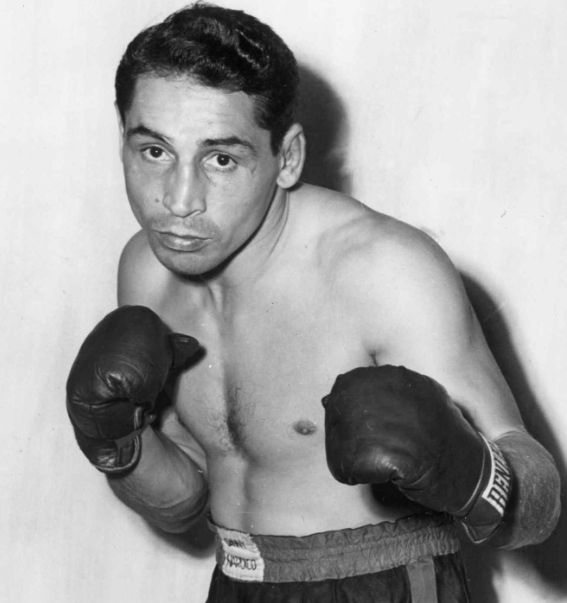Danny Nardico: The Only Fighter to Drop Jake LaMotta
By Dan Cuoco
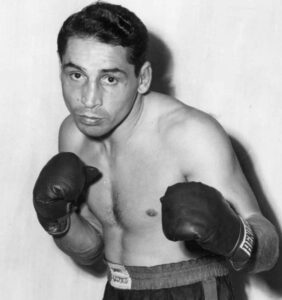 Daniel Richard Nardico was born on Friday, July 3, 1925, in Painesville, Ohio. In his pre-teens, he learned to fight to defend himself against bullies who picked on him at school for being poor. A guard in high school football at Harvey High in Painesville, Ohio, Danny was named All-Lake Shore League lineman—a credit to his ability to engage in close.
Daniel Richard Nardico was born on Friday, July 3, 1925, in Painesville, Ohio. In his pre-teens, he learned to fight to defend himself against bullies who picked on him at school for being poor. A guard in high school football at Harvey High in Painesville, Ohio, Danny was named All-Lake Shore League lineman—a credit to his ability to engage in close.
In the summer of 1942, at age 17, he persuaded his mother to let him join the United States Marine Corps because he wanted to fight for his country. The Marines sent him to California for basic and advanced training. Soon after, he was sent to the South Pacific with the First Marine Division.
At age 18, he participated in the Battle of Okinawa and suffered shrapnel wounds in his legs and back while leading a rifle squad.
He was awarded two Purple Hearts and a Silver Star for his bravery in the Battle of Okinawa and later for serving in the U.S. Marines during the Korean War.
Nardico turned professional in 1949 and was later quoted as saying, “After World War II, everything in life is a cakewalk.” He established himself as a top world-rated light-heavyweight contender, and from June 1951 to February 1955, he was rated as high as number three in the world by Ring magazine.
California
In 1946, Nardico was discharged from the Marines in Chicago, but he decided to return to California and got a job in a printing office in Gardenia. He got married and left the printing office for a job as a mail carrier. It was while he was carrying mail he decided to become a fighter. Danny had done some boxing as an amateur in the Marines and decided to enter some amateur events in Los Angeles.
Deciding to turn pro after engaging in about a dozen amateur fights, Nardico believed he could make more money as a fighter than carrying mail, and engaged in nine fights for promoter Johnny Francis from August 5, 1949, to May 12, 1950, compiling a record of 6-1-2 (KO 5/KO by 1).
Danny’s first pro fight against Don Smith was held in Hollywood, and although he seemed to have an edge in the scoring, the fight ended in a draw. Next, he engaged Frankie Calzo and stopped him in four rounds. His next two fights occurred in Los Angeles, stopping Mack Woods in two rounds and Danny Mendez in three rounds.
He returned to Hollywood for his next five fights, stopping Monte Clark in three rounds, and in a four-round special event, he fought a draw with Enoch Lee. It was slam-bang action all the way, with the fans contributing to the excitement by showering both boxers with money at the finish. It was a close, exciting struggle, but it appeared that Nardico rated the edge.
Nardico’s unbeaten record ended in another four-round special against veteran Windmill Pearce (80-31-32). Pearce floored Danny in the first round and won on a t.k.o. in the fourth after drawing blood from one of Nardico’s eyes from an apparent head butt. Nardico won his final two fights in California, kayoing Joe Cardenas in five rounds and winning a four-round decision over Bob Gladson.
Connecticut
After the Cardenas fight, Danny’s manager decided to give up boxing and released him from his contract, and, in 1950, Nardico decided to go East and begin fighting for a living. “A couple of fighters in Los Angeles had been talking about going East, and I wanted to go with them,” Danny said. “My wife didn’t like fighting but agreed that it was best if that was what I wanted to do. So, I rode East with the two fighters, and we landed in Hartford, Connecticut.”
In June 1950, Nardico arrived in Hartford, and from June 21, 1950, to August 1, 1950, he engaged in five fights in Connecticut and one in Massachusetts, compiling a record of 2-2-2 (KO 1).
Nardico’s debut on June 21, 1950, was disappointing, as he dropped a six-round decision to Neil Wallace in Waterbury, Connecticut. Five days later, he kayoed Wally Reagan in three rounds in Hartford, Connecticut. Danny traveled to North Adams, Massachusetts, for his next fight, dropping a six-round split decision to Jackie Harris.
He returned to Connecticut, fought a six-round draw with Harold Simpson in Bridgeport, won a six-round decision over tough Rocky Jones from Chester, Pennsylvania, in Hartford, and fought a six-round draw with classy Brooklyn, New York middleweight Willie Dockery in Hartford.
Willie Pep’s veteran manager, Lou Viscusi, watched Nardico work and started helping him. At the time, the caliber of fighters around Hartford was too experienced, so Viscusi phoned Tony Cancela and said he was sending Danny to Tampa, Florida, to work out and get some experience.
Florida
In August 1950, Nardico moved with his family to Tampa, Florida, and fought under the management of Tony Cancela, co-manager Lou Viscusi, and trainer Bill Gore. “When I arrived,” Nardico said, “I liked it here so much I decided to make it my permanent home.”
From August 11, 1950, until December 12, 1950, Nardico engaged in fourteen fights, winning ten by kayo, three by decision, and losing one by disqualification. He started his Florida residency with six consecutive kayos: Irwin Schulz (KO 2), Ray White (TKO 3), Bill Leonard (KO 1), Buck Garrett (TKO 2) in Tampa; Danny Ruggerio (TKO 9) in Jacksonville; and Whitey Berlier (KO 1) in Tampa.
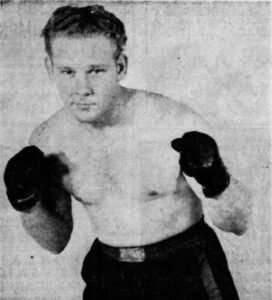
The Berlier fight was Nardico’s first featured fight and proved he was ready to move up in competition. Danny stunned the crowd of 3,000 when he ended the fight at 39 seconds of the first round. The Tampa Times reported: “The crowd had hardly settled when Dynamite Dan unleashed a terrific right-hand punch that found its mark on the unprotected chin of Berlier. Nardico had so much momentum on the punch that he went along for the ride, sprawling squarely on top of the stricken visitor from New Orleans.
By the time his vision cleared, well after Referee Young Raymond tolled the 10-count, the Tampa belter was dancing a jig in his corner, undoubtedly envisioning juicier plums in the offing. Apparently, Dynamite Dan had failed to read Berlier’s press clippings, which had included a seven-round go with Tommy Gomez last Winter, and a close decision loss to light-heavyweight champ Joey Maxim, for he started the dynamite sputtering at the outset of the round by jolting Berlier with a hard right to the stomach. He followed this with a left to the head. Berlier sought refuge on the far side of the ring, but there was no escape and it was all over. Nardico came in at 176 to 195 for Berlier.”
Six days after the Berlier fight, Nardico was in Macon, Georgia, winning a ten-round split decision over tough club fighter Fred Kruger. On October 17, 1950, Nardico’s seven-fight winning streak ended in Jacksonville, Florida, when he lost on a foul in the third round to Charlotte, North Carolina’s Joe Lassiter, who was floored twice in the third round by what the referee ruled were rabbit punches. Lassiter was in pain after the last knockdown, and the referee did not start a count. Instead, he signaled it was over. Before the knockdowns, the referee had warned Nardico several times about hitting his opponent on the back of the neck.
Nardico kayoed his next three opponents: Johnny Taylor (KO 2) in Jacksonville, heavyweight Art Seay (KO 2) in Tampa, and John Wilder (TKO 4) in Orlando.
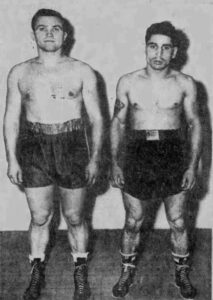
On November 28, 1950, Nardico won a ten-round unanimous decision over heavyweight Big Bill Wilson in Tampa. Wilson outweighed Danny by 35 pounds (212 to 177). The fight was a bloody slugfest from start to finish. Danny dropped Wilson in the third round with a left hook to the jaw, but Wilson recovered and rallied and held Nardico even in the fourth and won the fifth with heavy punching of his own. It was a hammer-and-thongs slugfest from the sixth round, with Nardico carrying the heavier guns but Wilson matching punches with him on fairly even terms until the last two rounds.
In the ninth, Nardico opened a couple of cuts on Wilson’s face, and in the tenth, Wilson’s head and chest were covered with blood from the cuts around his eyes. But Wilson never stopped trying, and in the last ten seconds of the tenth round he landed a hard right that knocked Nardico across the ring. Wilson failed to hear the bell and landed three more punches after the bout ended.
On December 6, 1950, Danny stopped Florida’s top unbeaten prospect Hal Boylston in the sixth round in Jacksonville. Nardico was sent to the canvas in the fifth round by a left hook, but in the next round a Nardico left hook sent Boylston down for a nine count. He was then met with a series of devastating punches, and the bout was stopped. Danny won a ten-round decision over tough veteran Tony Masciarelli in Jacksonville six days later.
World Title Contender
In 1951, Danny engaged in fourteen fights, winning nine by kayo, three by decision, losing one by decision, and one by technical knockout. In January, he met journeyman Tony Gillo twice, stopping him in three rounds in West Palm Beach and kayoing him in one round in Sarasota.
In February, he won a unanimous decision over tough Sonny Horne in Tampa and kayoed Charley Mercer in one round in Miami Beach. In April, he kayoed O’Neal Crocker in two rounds and stopped world light heavyweight contender Nick Barone in ten rounds in Miami Beach.
Barone was an 11-5 favorite and piled up a big lead in the early rounds, but Danny came on in the sixth and began landing hard blows to the head. He floored Barone with a left hook to the head in the tenth. Barone bounced up but took an eight count. Seconds later, Nardico cornered Barone and put him down again. He was up at the count of nine, but Referee Eddie Coachman stopped the fight. Nardico’s victory moved him into Ring magazine’s world light heavyweight ratings for the first time at number ten.
On May 9, 1951, Nardico fell victim to a technical knockout in the fourth round against number six world light heavyweight contender Irish Bob Murphy (57-5-1, 51 kayos) in a savage, one-sided battle, nationally televised fight at Chicago Stadium. Danny’s showing did not disgrace him.
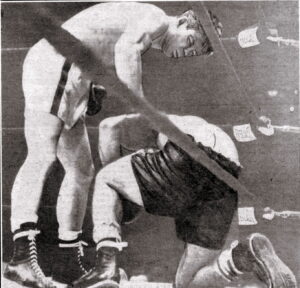
He lived up to his reputation as a terrific puncher and won the first round with a two-fisted attack. But his inexperience and zeal proved his undoing. He left himself open when Irish Bob opened the second round with long, heavy left hooks. One sent Danny reeling, obviously hurt. He never seemed to recover from that blow but waged a seething battle through the rest of the second and third rounds. Nardico shook Murphy several times.
More often, though Irish Bob was jolted, he was still able to catch Danny with wide left hooks and long rights to the head and body. Soon after the fourth opened, Murphy crowded Nardico into his own corner and dropped him with a flurry of two rights and a left hook to the head and body. The knockdown blow was a chopping right to the jaw. Up and reeling at nine, Nardico was helpless when Referee Johnny Behr stopped the fight, awarding Irish Bob a TKO.
After the fight, sports reporter Wilbur Kinley of The Tampa Times stated, “Nardico obviously was in far over his head, but at 23, he is a long way from through and definitely has a good future in the ring. They may have hurried him along a little too fast in this one, but this kid has it, and we believe he can come back strongly.”
The victory earned Murphy a lucrative fight with Jake LaMotta, who was making his first start as a light-heavyweight, while the loss dropped Danny from the Ring ratings.
Danny returned to action in Miami on June 12, 1951, winning a split decision over veteran Reuben Jones of Norfolk, Virginia. The fight was close, but Nardico pulled ahead at the end to secure victory. The pair met in a rematch fifteen days later in the semi-final of the Jake LaMotta – Irish Bob Murphy main event at Yankee Stadium. In his New York debut, Danny scored an impressive third-round technical knockout.
On July 23, 1951, Nardico stopped veteran Anton Raadik of Chicago in the second round at the Bayfront Park Auditorium in Miami. Nardico hammered Raadik with rights and lefts in the opening round, and a left and a right to the mouth dropped him in the second. Raadik reached his knees at the count of five and stood up at nine, but Referee Billy Regan stopped the fight. Boxing Commission Physician Dr. James McCormick recommended that Raadik retire, and his manager, Tom Walsh, agreed.
On August 14, 1951, Nardico gave away 47 pounds to 219-pound Big Bill Wilson in Jacksonville but pounded him to the floor four times and stopped him in the fifth round. In the third round, Danny connected with a left hook, sending Wilson reeling through the ropes for a nine count. Wilson went down thrice in the fifth round, and Referee J.P. Stanley stopped the fight at the bell. (Danny had previously beaten Wilson by a unanimous ten-round decision in November 1950.)
A month later, in Miami Beach, Danny won a ten-round majority decision over tough Brooklyn heavyweight George Kaplan. Sixteen days later, Nardico and Kaplan met again at St Nicholas Arena in New York in a televised fight. Danny, twenty-one pounds lighter and three inches shorter than Kaplan, came from behind and knocked out Kaplan in the eighth round. Nardico’s six-fight winning streak returned him to Ring magazine’s top ten ratings at number ten.
On December 5, 1952, Nardico was matched in a nationally televised fight with Ring magazine’s number one world light heavyweight contender Harry (Kid) Matthews at Cleveland Arena, which was the feature on the Cleveland News annual toyshop fund. Matthews entered the fight with an eight-year, forty-seven-fight unbeaten streak, and a record of 76-3-5, 54 kayos.
Matthews extended his streak against Nardico, but ran into unexpected opposition in winning a ten-round decision. Although Nardico received a thorough pasting, his dynamite fists hurt Matthews several times. Matthews pounded Nardico’s face into a crimson pulp and straightened him up repeatedly with pile-driving blows to the body. But he had difficulty avoiding Nardico’s hard smashes to the head and fought a noticeably more cautious fight after getting nailed with stiff punches in the third round.
The loss did not hurt Danny’s standing in the Ring magazine ratings, and he retained his number ten rating. Subsequent losses sustained by Bob Murphy, Yolande Pompey, Don Cockell, Wesley Bascom, and Bob Satterfield elevated Danny to number five for the Ring ratings period ending January 15, 1952.
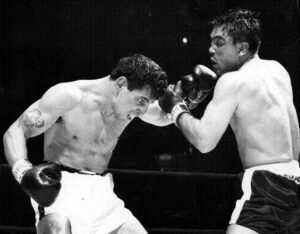
In late January 1952, The International Boxing Club (IBC) announced they had signed Danny to fight six-ranked middleweight contender Robert Villemain on February 22 in a nationally televised bout at Madison Square Garden. Villemain was known to American audiences for his victories over Jake LaMotta and Kid Gavilan. He had extended Sugar Ray Robinson over fifteen rounds for the Pennsylvania version of the middleweight title and was an experienced fighter with a rock-iron chin.
The busy Villemain, 167½ pounds, staged a blistering rally in the last two rounds to win a unanimous decision over Nardico, 172 pounds. Danny forced the fighting in every round and landed some good punches at long range to the body and head in the first, second, seventh, and eighth rounds. But the rugged Villemain’s bobbing and weaving tactics and his “ear-lap” defense of forearms and gloves made Danny miss many more punches than he landed in the other rounds.
Meanwhile, Villemain jumped in with left hooks and straight rights, beating Danny at close quarters. In the last minute of the 10th round, Villemain rocked the tiring Nardico twice with straight rights and ripped a gash under his right eye with a left hook. Nardico lost the third round on a foul for two low blows. The decision was unanimous in favor of Villemain and dropped Danny to seventh in the Ring ratings.
From March 1952 to October 1952, Danny ran off a nine-fight winning streak with victories over Dick Wagner (W UD 10) and Lalu Sabotin (W UD 10) in Cleveland, Ohio; Ted Gories (KO 2) in Daytona, Florida; Joe Blackwood (W UD 10) in Milwaukee, Wisconsin; Bernie Reynolds (KO 2) in Miami Beach, Florida; Lalu Sabotin (TKO 5) in a return match in Cleveland, Ohio; Gordon Pouliot (KO 3) in Tampa, Florida; Cecil Hudson (W UD 10) in Louisville, Kentucky; and his third win over Big Bill Wilson (W UD 10) in Augusta, Georgia. The victories earned Danny a step up in the Ring ratings to number six.
Philadelphia heavyweight Dan Bucceroni (42-3-0, 31 kayos) snapped Nardico’s nine-fight winning streak by winning a ten-round unanimous decision on November 14, 1952, in a nationally televised fight from Madison Square Garden. The six-foot-two, 185-pound Bucceroni substituted for an ill Jake LaMotta and was a 2-1 favorite.
In the early rounds, it was all Bucceroni as his long-arm left hooks thudded home time after time to the 175-pound Nardico’s face. But, all the time, Danny was crowding in, swarming to the attack, trying to get inside Bucceroni’s flailing arms. In the eighth, Nardico hurt Bucceroni with a right to the jaw – his best punch of the night. A smashing right over Nardico’s left ear early in the tenth scored the only knockdown of the grueling fight.
Nardico had no excuses in his dressing room. “I didn’t think he had that much in him. I trained for a short guy (LaMotta) and a different style. Every time I looked up, those long arms were coming at me. He’s kind of cute inside too.”
Jake LaMotta
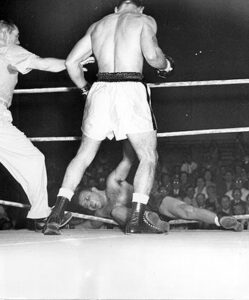 On December 31, 1952, in the first fight televised out of Florida, Nardico scored a seventh-round technical knockout over former middleweight champion Jake LaMotta at the Coral Gables Coliseum in Miami, Florida. A smashing right knocked LaMotta down for the first time in his career early in the seventh round, and when the round ended, LaMotta was hanging helplessly to the ropes, his eyes glazed, as Nardico beat him with merciless rights and lefts. Nardico was the aggressor and built a big lead, utilizing left jabs and good right crosses to the head. LaMotta concentrated on Nardico’s body with left hooks but couldn’t slow him down.
On December 31, 1952, in the first fight televised out of Florida, Nardico scored a seventh-round technical knockout over former middleweight champion Jake LaMotta at the Coral Gables Coliseum in Miami, Florida. A smashing right knocked LaMotta down for the first time in his career early in the seventh round, and when the round ended, LaMotta was hanging helplessly to the ropes, his eyes glazed, as Nardico beat him with merciless rights and lefts. Nardico was the aggressor and built a big lead, utilizing left jabs and good right crosses to the head. LaMotta concentrated on Nardico’s body with left hooks but couldn’t slow him down.
In the seventh round, Danny caught the fifth-ranked LaMotta with a left hook to the jaw that stunned him and followed up with a right, a left, and another right, all to the jaw. LaMotta staggered backward and collapsed into the ropes in his own corner, almost falling into the crowd. LaMotta got to one knee at four and took an eight count. Nardico, realizing that he had LaMotta on the way out, went right after him and finally got him in a corner. For a full minute, Jake stood helpless, his right hand holding the top strand of the rope for support as Nardico threw a stream of lefts and rights to the head. LaMotta wobbled but wouldn’t go down. As the round ended, Jake, his face bloody and puffed, staggered uncertainly to his corner.
After an examination by the Florida Boxing Commission doctor, his seconds yelled to Referee Bill Regan: “That’s all.” Nardico was leading on all cards at the time of the stoppage. Jake said that his first knockdown hadn’t hurt – as he had surmised it would – that it was a lot different than he had expected. “You don’t feel anything,” Jake said, “It just happens. My head was spinning, but I knew what was going on. A funny experience.” The win elevated Danny to number three over the inactive Harry (Kid) Matthews in the Ring world ratings, behind Joey Maxim and Harold Johnson.
Joey Maxim
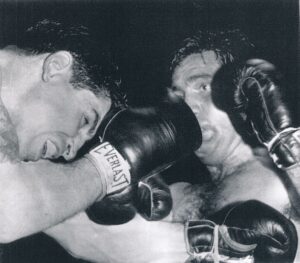
Danny’s victory over LaMotta earned him Ring magazine’s Fighter of the Month, and an opportunity to meet former light heavyweight champion Joey Maxim, with the winner named the logical contender for a title fight with champion Archie Moore.
Danny and Joey met on March 3, 1953, at Miami Stadium in front of 5,525 fans. Maxim gave Nardico an early boxing lesson but had to get up off the floor from a seventh-round knockdown to win a unanimous decision.
Jabbing with his left and grabbing with his right, Maxim made Nardico miss with his wild swings and piled up a wide margin early. Time after time, Maxim flicked his annoying jab in Nardico’s face, drawing taunts from Danny to “come on and fight.”
Maxim threw his right hand more often than usual against Nardico. Apparently, Nardico’s sneering remarks, “so you’re a champ, let’s see you fight,” affected Maxim, who seemed determined to knock him out. Leaving himself open for Nardico’s long overhand right, he caught a blow on the side of the head in the seventh round that dropped him for the first time since suffering a flash knockdown to Roy Hawkins in May 1948. Joey got up at four but had to take the mandatory eight count. He held on to weather Nardico’s only threat.
Nardico Continues with Mixed Results
Not stopping to take a rest, Danny was back in the ring on March 24, 1952, knocking out Nash Karahan in the first round in Tampa, Florida. On April 21, 1952, he traveled to Milwaukee, Wisconsin, and looked slow, dropping an upset unanimous decision to Larry Watson. On June 16, 1952, and July 7, 1952, Danny defeated Lalu Sabotin by a majority decision, first in Tampa, Florida, and then a unanimous decision in Miami Beach. On September 17, 1952, he knocked out Herman Harris in the seventh round in the first sanctioned mixed-race bout in South Carolina.
In his last fight of the year, he knocked out Jackie Bennett in the first round on November 5, 1952, in Macon, Georgia. Danny ended the year as Ring magazine’s fourth-ranked light heavyweight contender behind Harold Johnson, Joey Maxim, and Yolande Pompey.
Charley Norkus
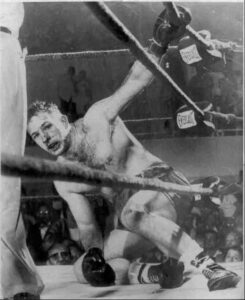
In January 1954, Danny engaged heavyweight Charley Norkus in one of the bloodiest bouts ever staged in South Florida. There were eight knockdowns. Norkus, 197 pounds, 15 ½ more than Nardico, battered Danny with smashing rights and dropped him to the canvas six times before Referee Jimmy Peerless stopped the fight at 2:15 of the ninth round.
But it wasn’t a one-sided fight. Both fighters took a lot of punishment and were bleeding freely. Norkus went down twice under Nardico’s powerful punches. Ringsiders were splattered with blood from Norkus’ nose and left eye and Nardico’s mouth.
Norkus staggered Nardico in the first round with a looping right and hurt him again in the second before he floored him with a looping right near the end of the round. Nardico took an eight count and was holding on at the bell. Charley floored Danny three times in the third and twice more in the ninth.
Before the fight both principals agreed three knockdowns in one round would not automatically stop the bout if the referee thought the man could continue. Nardico rallied in the fourth, worked Norkus into the ropes, and caught him coming off, sending him down for the mandatory eight count.
And in the seventh, after both had absorbed some terrific blows, Nardico connected with a one-two series, and Norkus was lying on his back at the bell. After going down twice in the ninth, Nardico was on his feet but defenseless as Norkus pounded him along the ropes, and that’s when the referee stopped the slaughter.
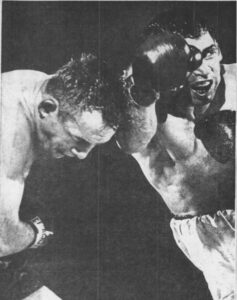
A nationally televised rematch in Miami Beach on March 24, 1954, disappointed the fans expecting a repeat of their earlier bout—this time Norkus won a 10-round unanimous decision without scoring a single knockdown. Danny tried to force the fight throughout, and he landed enough blows to bloody Norkus’ mouth, nose, and two brow cuts. But Norkus consistently landed left hooks and looping rights, staggering Danny multiple times, four in the last round, to walk away with a unanimous decision.
After the fight, Nardico said, “I’m convinced. No more heavyweights for me. It’s just too tough, giving up all that weight to a guy like Norkus.”
Nardico concluded his boxing career with two fights in 1954, a third-round kayo over old rival Reuben Jones, a fourth-round technical knockout loss to Paul Andrews, and one in 1956, a fourth-round technical knockout of Saul Weingroff.
His final career record is 50-13-4 (KO 35/KO by 4) in 67 bouts.
After his boxing career, he worked various jobs and served eighteen years as recreational director of the Northern Nevada Correctional Center in Carson City. He retired in 1986 and settled in the El Dorado County town of Cool. He was inducted into the Sacramento Valley Boxing Association Hall of Fame in 1989.
Danny passed away on November 22, 2010, at the age of 85. Among his survivors were two daughters from an early marriage that ended in divorce. He was married for 48 years to his second wife, the former Rachel Mendoza. He was a gentle man who doted on his grandchildren and loved playing golf. Diagnosed with Alzheimer’s disease in 2000, he and his wife moved from Cool to live with his grandson Richard Galindo, Jr. in Sacramento.
Primary Sources: Ring Magazine, LA Times, New York Times, New York Daily News, Hartford Courant, Tampa Tribune, Tampa Times, Miami News, Orlando Star, Dayton Daily News, Akron Beacon, Cincinnati Enquirer, Buffalo News, Louisville Courier, Alabama Journal, Spokane chronicle, and several online premium databases. I sincerely thank Roger Zotti for his insightful comments.
